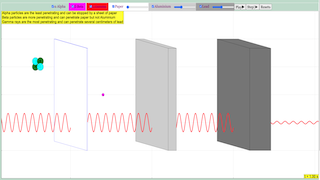https://www.youtube.com/watch?v=3t4b-inELNg
Credits
 [This email address is being protected from spambots. You need JavaScript enabled to view it.', 'Francisco Esquembre', 'Felix J. Garcia Clemente', 'fazli']
[This email address is being protected from spambots. You need JavaScript enabled to view it.', 'Francisco Esquembre', 'Felix J. Garcia Clemente', 'fazli']
Sample Learning Goals
[text]
For Teachers
Penetrating Abilities of Radioactive Emissions Simulation
One way to study the penetrating abilities of radioactive emissions is through simulation. A simulation is a computer program that models a real-world scenario, allowing scientists to explore the effects of different variables in a controlled environment. In this blog, we will explore a simulation that focuses on the penetrating abilities of radioactive emissions.
The simulation begins with a 3 sources of radioactive emissions that emits particles in all directions. For simplicity, we will only look at the one direction to the right of the screen. The user can turn on/off the type of particle being emitted, such as alpha, beta, or gamma particles. The simulation then shows how these particles interact with different materials, such as paper, aluminium or lead.
One of the key features of the simulation is the ability to adjust the thickness of the materials being used. This allows the user to see how different materials affect the ability of the particles to penetrate through them. For example, gamma particles are highly penetrating and can travel through thick layers of material, while alpha particles are less penetrating and can be stopped by a sheet of paper.
Another important feature of the simulation is the ability to view the particles in different situations (with/without paper, aluminium or lead.) The user can choose to view the particles as they move through the materials, or as they interact with atoms in the material. This allows for a deeper understanding of the mechanisms by which the particles interact with matter.
The simulation also includes a visualization that allow the user to see the amount of radiation absorbed by a material.
Overall, the penetrating abilities of radioactive emissions simulation is a powerful tool for exploring the effects of radioactive emissions on the environment and human health. By allowing users to adjust the variables and observe the results in real-time, the simulation provides a flexible and interactive way to study this important topic.
 |
| https://iwant2study.org/lookangejss/06QuantumPhysics_20nuclear/ejss_model_particlePenetration/ |
Penetrating Abilities of Radioactive Emissions
The penetrating abilities of radioactive emissions are determined by the type of radiation emitted. Alpha particles are the least penetrating and can be stopped by a sheet of paper. Beta particles are more penetrating and can penetrate several millimeters of skin. Gamma rays are the most penetrating and can penetrate several centimeters of lead. The penetrating abilities of radioactive emissions are important in determining the hazards of radioactivity because the more penetrating the radiation, the more likely it is to cause tissue damage and cancer.
 |
Research
[text]
Video
[text]
Version:
Other Resources
[text]
end faq
{accordionfaq faqid=accordion4 faqclass="lightnessfaq defaulticon headerbackground headerborder contentbackground contentborder round5"}
- Details
- Written by Loo Kang Wee
- Parent Category: 06 Modern Physics
- Category: 02 Nuclear
- Hits: 9934









